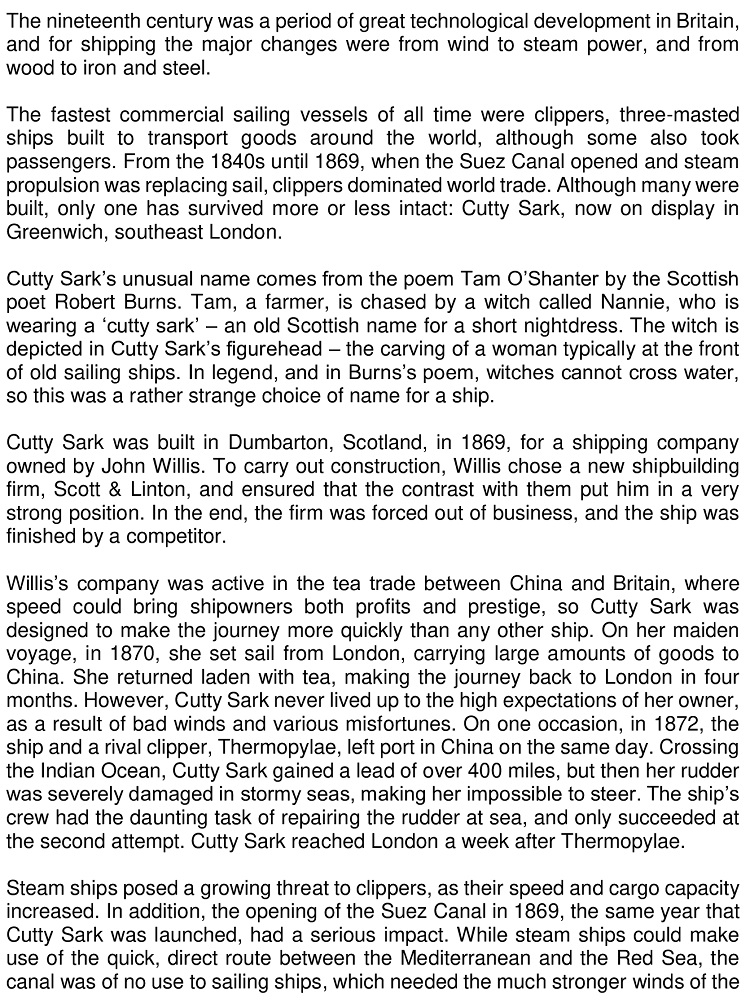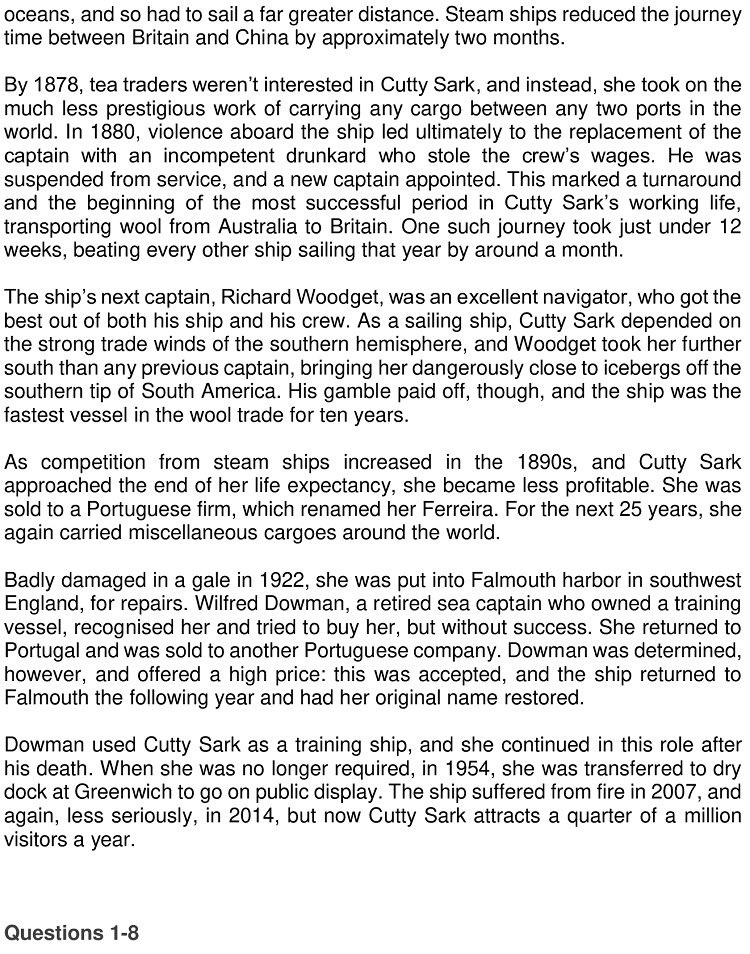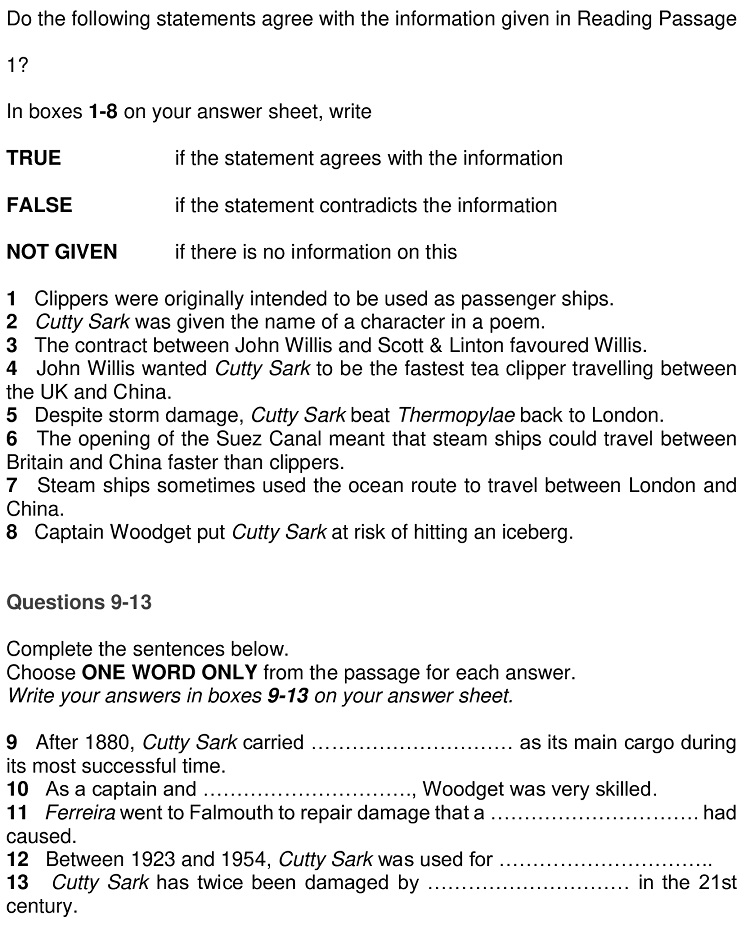Cutty Sark Reading Answers
6 min read
Updated On
-
Copy link
Table of Contents

Limited-Time Offer : Access a FREE 10-Day IELTS Study Plan!
The Academic passage “Cutty Sark: the fastest sailing ship of all time” is a reading passage that appeared in an IELTS Test. Ideally, you should not spend more than 20 minutes on a passage. Let’s see how easy this passage is for you and if you’re able to make it in 20 minutes. If not, try more IELTS reading practice tests from IELTSMaterial.com.
The question types found in this passage are:
Sentence Completion:
In these types of questions, you are required to complete the sentences by going through the passages and locating the sentences asked in the question. Then, fill in the blanks with the missing words or phrases and make the sentence complete and meaningful in relation to the passage. You might/might not get the exact phrases/words from the passage; hence, pay close attention to the passage.
True/False/Not Given
In this type of question, you are required to give an answer using True, False, or Not Given with respect to the statements made. If you believe that the given statement is mentioned in the text and holds true, write ‘True’. If you think the statement is wrong, write ‘False’. And, in case you do not find any piece of information regarding the given statement, write ‘Not Given’.
Cutty Sark: the fastest sailing ship of all time



Answers
1 Answer: False
Question Type: True/False/Not Given
Answer location: Paragraph 2, Lines 1-2
Answer explanation: “The fastest commercial sailing vessels of all time were clippers, three-masted ships built to transport goods around the world, although some also took passengers.” This line suggests that, originally, clippers were intended to transport goods and only some of them carried passengers.
2 Answer: False
Question Type: True/False/Not Given
Answer location: Paragraph 3, Lines 1-3
Answer explanation:“Cutty Sark’s unusual name comes from the poem Tam O’Shanter by the Scottish poet Robert Burns. Tam, a farmer, is chased by a witch called Nannie, who is wearing a ‘cutty sark’ – an old Scottish name for a short nightdress.” From this quoted line, we can state that the statement is false; cutty sark was the name of a dress and not a character of the poem.
3 Answer: True
Question Type: True/False/Not Given
Answer location: Paragraph 4, Lines 2-3
Answer explanation: “Cutty Sark was built in Dumbarton, Scotland, in 1869, for a shipping company owned by John Willis. To carry out construction, Willis chose a new shipbuilding firm, Scott & Linton, and ensured that the contrast with them put him in a very strong position.” This phrase ‘put him in a strong position’ suggests that the contract favoured Willis.
4 Answer: True
Question Type: True/False/Not Given
Answer location: Paragraph 5, Lines 1-2
Answer explanation: “Willis’s company was active in the tea trade between China and Britain, where speed could bring shipowners both profits and prestige, so Cutty Sark was designed to make the journey more quickly than any other ship.” This line suggests that Wills wanted Cutty Sark to be the fastest ship for the trade between UK and China and was designed in such a way that it made it the fastest ship for the purpose.
5 Answer: False
Question Type: True/False/Not Given
Answer location: Paragraph 5, Lines 7-11
Answer explanation: “On one occasion, in 1872, the ship and a rival clipper, Thermopylae, left port in China on the same day. Crossing the Indian Ocean, Cutty Sark gained a lead of over 400 miles, but then her rudder was severely damaged in stormy seas … Cutty Sark reached London a week after Thermopylae.” These concluding sentences of the fifth paragraph suggest that Cutty Sark couldn’t withstand the storm and could not defeat the Thermopylae on the journey to London.
6 Answer: True
Question Type: True/False/Not Given
Answer location: Paragraph 6, Lines 2-7
Answer explanation:“the opening of the Suez Canal in 1869, the same year that Cutty Sark was launched, had a serious impact. While steam ships could make use of the quick, direct route between the Mediterranean and the Red Sea, the canal was of no use to sailing ships, which needed the much stronger winds of the oceans, and so had to sail a far greater distance. Steam ships reduced the journey time between Britain and China by approximately two months.” This part explains that steamships could travel faster in the Suez Canal between Britain and China than Clippers and reduced the journey by two months.
7 Answer: Not Given
Question Type: True/False/Not Given
Answer location: N/A
Answer explanation: There is no reference to this context that the steam ships took an ocean route to travel London and China.
8 Answer: True
Question Type: True/False/Not Given
Answer location: Paragraph 8, Lines 3-4
Answer explanation: “As a sailing ship, Cutty Sark depended on the strong trade winds of the southern hemisphere, and Woodget took her further south than any previous captain, bringing her dangerously close to icebergs off the southern tip of South America.” This line suggests that Woodget took Cutty Sark to the south where it had a risk of hitting an iceberg.
9 Answer: Wool
Question Type: Sentence Completion
Answer location: Paragraph 7, Lines 3-6
Answer explanation: “In 1880, violence aboard the ship led ultimately to the replacement of the captain…This marked a turnaround and the beginning of the most successful period in Cutty Sark’s working life, transporting wool from Australia to Britain.” This lines suggest that transportation of wool was the primary cargo of Cutty Sark during its most successful time in 1880.
10 Answer: Navigator
Question Type: Sentence Completion
Answer location: Paragraph 8, Introductory line
Answer explanation: “The ship’s next captain, Richard Woodget, was an excellent navigator, who got the best out of both his ship and his crew.” This suggests that Woogdet was a navigator and a captain who was skilled enough to get the best out both his crew members and the ship.
11 Answer: Gale
Question Type: Sentence Completion
Answer location: Paragraph 10, Line 1
Answer explanation: “Badly damaged in a gale in 1922, she was put into Falmouth harbour in southwest England, for repairs.” This shows that the ship, Cutty Sark renamed as Ferreira, was damaged severely by a gale.
12 Answer: Training
Question Type: Sentence Completion
Answer location: Paragraph 11, Lines 1-2
Answer explanation: “Dowman used Cutty Sark as a training ship, and she continued in this role after his death.When she was no longer required, in 1954, she was transferred to dry dock…” Hence, Cutty Sark was used as a training ship for nearly 31 years from 1923 to 1954 after which she was sent to Greenwich.
13 Answer: Fire
Question Type: Sentence Completion
Answer location: Paragraph 11, Lines 3-4
Answer explanation: “The ship suffered from fire in 2007, and again, less seriously, in 2014, but now Cutty Sark attracts a quarter of a million visitors a year.” Hence, the ship was damaged twice, in 2007 and 2014, by fire.
Check More IELTS Reading Answers
Practice IELTS Reading based on question types

Start Preparing for IELTS: Get Your 10-Day Study Plan Today!
Recent Articles

Nehasri Ravishenbagam

Haniya Yashfeen

Haniya Yashfeen

Haniya Yashfeen




Post your Comments